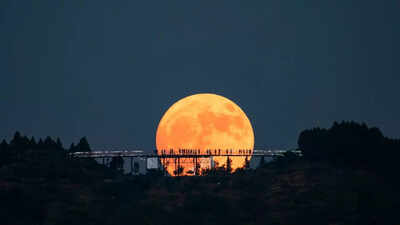On the night of 6 November 2025, sky-watchers will be treated to one of the most striking celestial events of the year. The November supermoon, often called the Beaver Moon, will be the closest full moon of 2025, appearing noticeably larger and brighter than any other moon this year. This extraordinary alignment occurs when the full moon coincides with its perigee, the point in its orbit nearest to Earth, making it appear up to 14% bigger and 30% brighter. Visible to the naked eye without any special equipment, the supermoon offers a rare spectacle for astronomy enthusiasts, photographers, and casual observers alike, creating a breathtaking opportunity to appreciate the moon’s full splendour under clear night skies.
What is a supermoon and why does it appear bigger and brighter
A supermoon is not just any full moon. It occurs when the moon reaches its perigee, the closest point in its elliptical orbit around Earth, at the same time it is full. Because the moon’s orbit is slightly oval-shaped rather than perfectly circular, its distance from Earth fluctuates throughout the month.When the perigee coincides with a full moon, the lunar surface appears larger and brighter than usual. NASA estimates that the moon can look up to 14% bigger and 30% brighter than the faintest full moon of the year. This difference, while subtle to the casual observer, can produce a striking and almost tangible effect in the night sky.The term “supermoon” was first coined in 1979 by astrologer Richard Nolle and has since entered popular vocabulary as a way to describe this visually enhanced lunar event.
When and how to view November’s closest supermoon of 2025
The November supermoon will officially reach its full phase on 6 November at 1:20 PM GMT (2:20 PM CET). While it can be observed on the evenings immediately before and after, the optimal viewing window is shortly after sunset on 6 November, when the moon rises above the horizon.In 2025, this will be the second of three supermoons, and it will also be the closest of the year, with the moon approaching within just under 222,000 miles (357,000 kilometres) of Earth. Its brightness and proximity make this particular supermoon an exceptional sight, worthy of both casual observation and photographic documentation.
How to observe the supermoon
Viewing the supermoon is simple. No telescopes or binoculars are required – just clear skies and an unobstructed horizon. However, while the moon will appear slightly larger, the difference in size is often subtle. Shannon Schmoll, director of Abrams Planetarium at Michigan State University, explains that the change is “most obvious as a comparison between other images or observations.”For photography enthusiasts, the supermoon provides excellent opportunities. A telephoto lens can capture the moon’s surface details, while including foreground elements like buildings, trees, or water can create a sense of scale and drama. Time-lapse photography is also ideal to show the moon rising and slowly moving across the sky.
November supermoon brightens the night sky for observers worldwide
Because the moon will be closer than usual, its gravitational pull on Earth’s oceans will be slightly stronger, causing marginally higher tides. Astronomer Lawrence Wasserman of Lowell Observatory notes, however, that this effect is generally subtle and unlikely to have significant impact on most coastal areas. November’s full moon is traditionally called the Beaver Moon, a name derived from the time when beavers prepare lodges for winter. Historically, full moons have been important markers for seasonal and agricultural cycles, often holding cultural and symbolic significance.In 2025, the Beaver Moon stands out as the brightest and closest supermoon of the year, making it especially noteworthy. Its visual impact, combined with its historical and cultural resonance, ensures that it will be remembered as a highlight of the year’s celestial events.
December brings the final supermoon of the year
If you miss the November supermoon, there is still one more chance in 2025. The final supermoon of the year will occur on 6 December, offering another opportunity to observe the moon at its closest and most luminous. Each supermoon provides a unique chance to connect with the cosmos and witness the subtle rhythms of our solar system in action.
Tips for enjoying the supermoon
To make the most of this celestial event, consider the following:
- Find a location with a clear view of the horizon.
- Ensure skies are clear and free of light pollution.
- Compare the moon’s apparent size with familiar objects for a better sense of scale.
- Use a camera with a telephoto lens or try time-lapse photography to capture its full impact.
Witnessing a supermoon is more than a visual spectacle; it’s a reminder of Earth’s relationship with its natural satellite. On 6 November 2025, the Beaver Moon will rise closer and brighter than it has all year, offering a magical moment to pause, look up, and marvel at the universe.Also Read | ISRO plans seven major space missions by March 2026 to boost India’s space growth and explore new heights Go to Source



